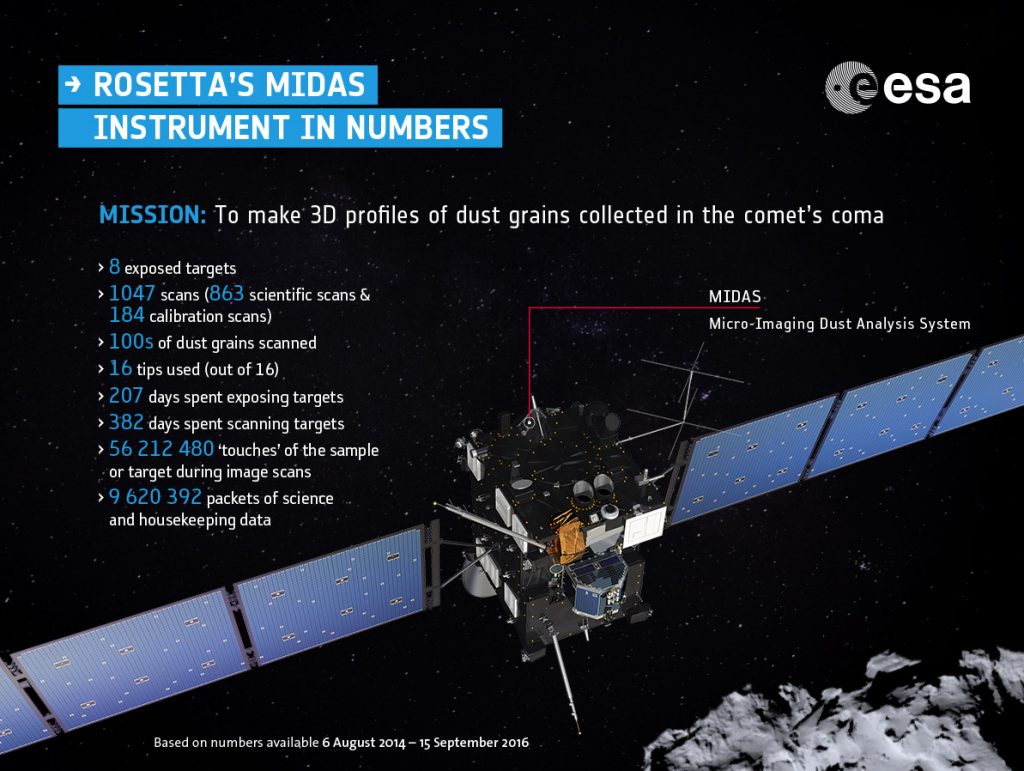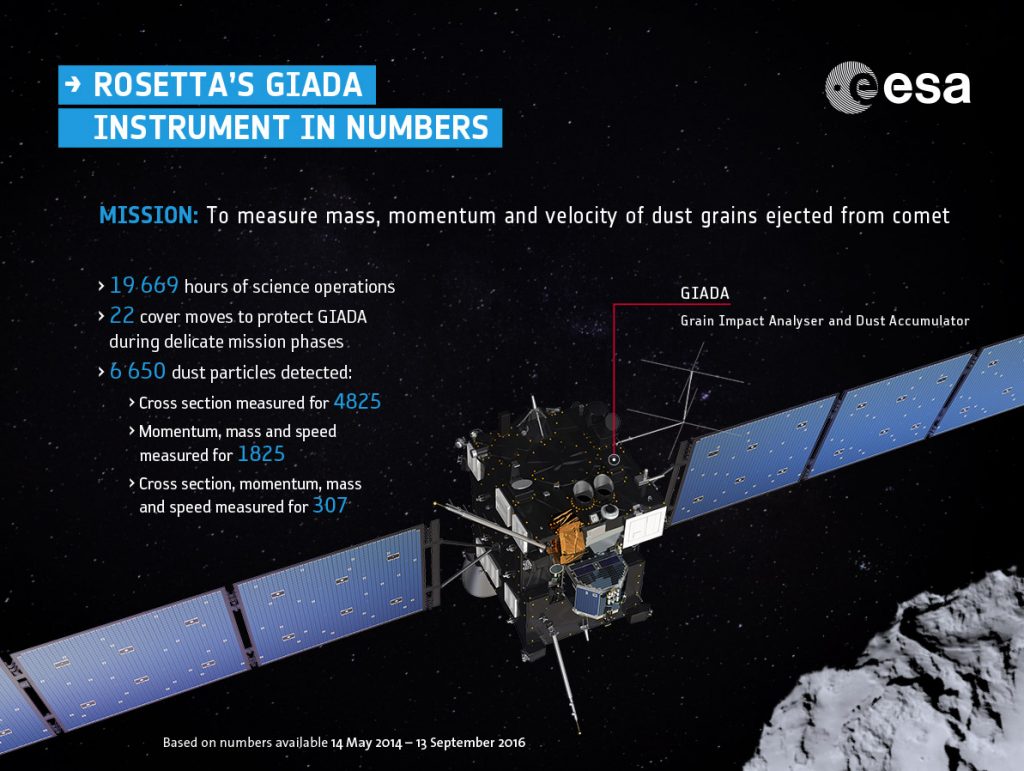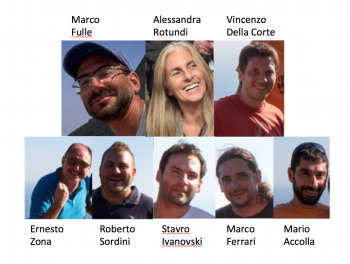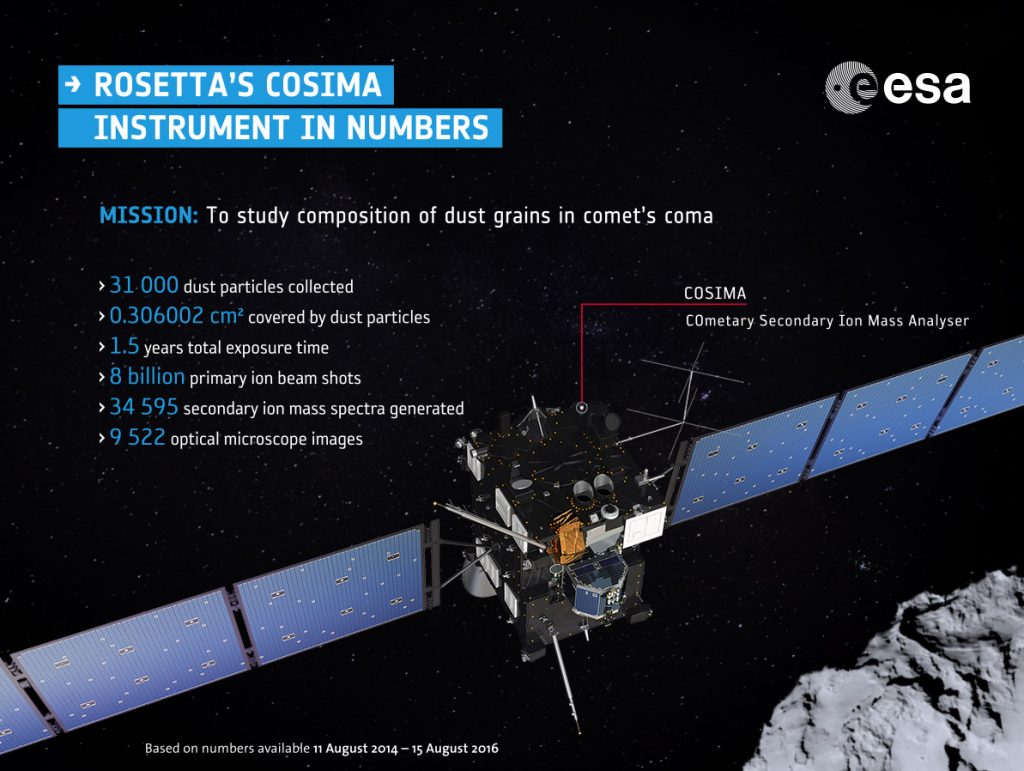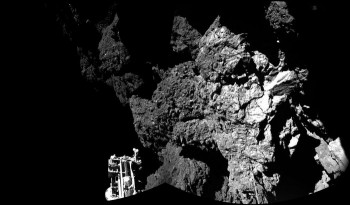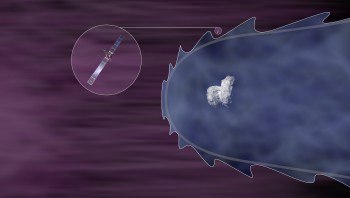26.09.2016
-
LIVING WITH A COMET: A MIDAS TEAM PERSPECTIVE
This is the first of a series of blog posts that delve behind the scenes of Rosetta's instrument teams to find out what it was really like "living with a comet" for two years, with some impressive statistics collected along the way.
Tasked with collecting and scanning – in 3D – the comet’s smallest dust grains, Rosetta’s Micro-Imaging Dust Analysis System (MIDAS) also has one of the smallest teams: “1.2 people in the beginning”, says principal investigator Mark Bentley. But as ever with Rosetta, the numbers are big: after two years of science, Mark and his PhD student Thurid Mannel report on the highs and lows of the 52 million up-down motions of the MIDAS scanning tip.
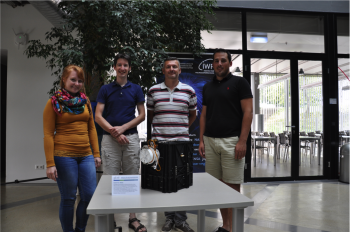
Team MIDAS: Thurid Mannel (PhD student), Mark Bentley (PI), Harald Jeszenszky (technical manager), and Roland Schmied (postdoc) with the MIDAS Qualification Model (QM). Image courtesy G. Kargl.
Mark reflects on the post-hibernation period, the overall performance of the instrument, and lessons learned for a future MIDAS:
The early days of the mission, when we were first starting operations after hibernation exit in January 2014 were pretty crazy – mainly because we were a rather small team, approximately 1.2 people comprised of me and 20% of Harald's time (Harald is MIDAS technical manager). As such I was trying to juggle many hats, from high-level science planning, to very low-level telecommand hacking – and being a father to a 3-month-old! The learning curve was also pretty steep. Although I’d been using the Flight Spare for several years, figuring out how the planning system worked and playing with real data was a challenge – but lots of fun. The only worrying moment came during one of the interactive checkouts, when Harald and myself were at ESOC watching the data come down “live”, when I realised that a parameter that controlled one of the motors was set wrong. Knowing that there was, at this point, nothing that could be done, I simply had to wait and watch the telemetry come down, hoping I hadn’t broken MIDAS before we had even got to the comet… Fortunately the engineers did their jobs very well, and everything was fine.
Overall the instrument has performed extremely well, but there are always things that could be improved for the next version. One key problem is that we could only expose a target to space to collect dust OR scan a target with the microscope – not both together. Ultimately the comet was and is an unpredictable beast, and so apart from applying high level factors (e.g. closer=better) it was something of a guessing game deciding when to expose and when to scan. So I was extremely happy in February 2016 – already into the extended mission – when we happened to be exposing a target during a gas and dust outburst. Not only did this give us a target covered in dust, but many other instruments were observing at the same time, so we have started to weave a coherent story about this event and the dust we have been imaging. In fact we got so much dust on this target, that we basically stopped exposing and decided to focus our attention on this one target.
And we’re still trying to image as much as possible – and will be doing to until about 12 hours before the orbiter “lands” on the surface of Comet 67P on 30 September.
MIDAS works by collecting and then physically scanning grains with an Atomic Force Microscope. This uses a very fine tip, a bit like an old-fashioned record player needle, that is scanned over a particle. The deflection of the needle and therefore the height of the sample are measured to build up a 3D picture. This enables scientists to determine the structure of the particle, and thus gain insight into how it might have formed.
MIDAS PhD student Thurid Mannel joined the team as an intern in May 2014, and started her PhD in June 2016. Here she shares the frustrations that went alongside the most joyous moments of scientific discovery:
I think the most surprising observation was after nearly three months at the comet and not detecting anything, we then recorded an image so distorted that we barely realised it was a large dust particle that we were looking at!
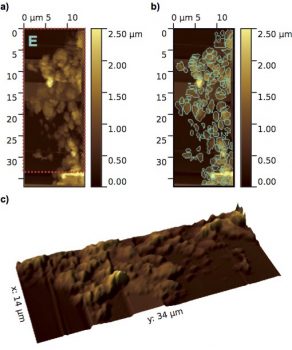
Atomic force microscope topographic images of MIDAS particle E, a loosely packed ‘fluffy’ aggregate comprising many grains. (a) Overview image with a pixel resolution of 210 nm and a colour scale representing height. b) Sub-units (grains) of the particle detected at the resolution of the instrument are outlined. (c) 3D image of the particle corresponding to the area covered by the red outline in (a) with two times height exaggeration to aid visualisation.
We had been exposing a facet from mid-September 2014 and looked for dust on it every now and then, but did not find anything… until 14 November. This was a great relief for us, since the other dust analysing instruments COSIMA and GIADA already sampled many dust particles. We celebrated our first dust and shared the image with you on this blog. Of course we wanted to discover more of this particle – but any attempt to re-scan it failed. Scans on different locations on this target either gave too distorted results for scientific use or were completely failing, the only bright spots were very few rather distorted, barely recognisable dust particles. It was quite an emotional roller coaster for us! Since scanning on this target resulted in more failed than successful scans we decided, with heavy-hearts, to give up on this particular target.
In December we exposed a fresh target and hoped for better images of cometary dust. The new target, however, showed no dust at all until end of December – and in January we were finally able to record my most favourite scan: it is shown in Mark’s recent Nature paper as particle E (see image left) and it really stands out in our whole particle collection. We knew this already in the moment we received the image – another absolute highlight for me.
Shortly after we were able to record our three smallest dust particles so far, one of them also presented in Mark’s paper as particle D. However, except for one other particle, additional scans on this facet showed no dust at all, just the empty facet.
After the safe mode in 2015 we had to stay so far from the comet that MIDAS did not detect any dust particles – a rather depressing time for us. It was the end of July when we decided to use the time to go back to the target with the first particle on, the one that we abandoned earlier. We started doing very coarse and very cautious overview-scans at locations distant from the ones we had all those problems at the beginning of the mission, and discovered that the whole target must be covered with large, fragile dust particles! This was the most surprising observation for me! We had all the dust collected in the beginning of the mission without knowing it! Their height, their enormous size, and their fragility were probably causing all the distortions at the beginning of the mission. Even now, when we know about the wealth of particles we collected on this facet, their sizes and fragility makes it hard for us to image them. With a lot of patiently tweaking the scanning parameters in the end we succeeded to image at least some of the enormous particles. No other target gave us such a hard time and no other target holds so many, and such large dust particles [note that large for MIDAS is a few tens of micrometers].
This story illustrates well that MIDAS is not an instrument with high statistics but rather with high precision. Every dust particle is a precious resource due to our limited dust collection slots. And thus, my second most surprising event was when we were collecting dust particles exactly during the outburst event in February 2016. What a lucky coincidence for MIDAS! The wealth of particles we collected could keep us going for years, if it weren’t for our consumables slowly running out – we’ve now used all 16 of our scanning tips.
Although in the beginning MIDAS did not have the best start, in the end we can look back at sampling dust from very different phases of cometary evolution, including different dust populations, sizes and morphologies. There is a lot of material still to be analysed to understand the dust of Comet 67P at the micrometre to nanometre size, which will be important to our understanding of how comets are built.
---
LIVING WITH A COMET: A GIADA TEAM PERSPECTIVE
Rosetta’s Grain Impact Analyser and Dust Accumulator GIADA has detected and measured the properties of some 6650 comet dust particles. Principal Investigator Alessandra Rotundi reports on the “beautiful results” that her team’s instrument has collected at Comet 67P/Churyumov-Gerasimenko.
GIADA has been on since May 2014, and we caught the first dust grain on 1 August 2014. The first love is never forgotten! It was the most exciting measurement, and such an emotion! I cannot say that it was unexpected, though; we actually estimated that we’d start detecting dust in that period, and in particular, one of the GIADA Co-Investigators (Eberhard Grün) foresaw exactly 1 August as the starting point for our dust detections!
Since then GIADA has collected 6650 dust particles. For 4825, the cross-sections are known, and for 1825, the momentum, mass and speed are also known. Among this group we also know the cross-section for 307 particles. We always hope for combined particle detections by the GDS (Grain Detection System) and the IS (Impact Sensor) subsystems because these combined detections provide the greatest number of information for individual dust particle, i.e. the momentum, the speed, the mass, the optical cross section and the density.
We’re very happy with what we’ve achieved, but of course there were times where we could not collect any dust due to routine operational activities of the spacecraft and when we were very far from the comet for spacecraft safety reasons. For example, there were times when we had to close the cover to protect the sensitive instrument interior during cruise phase, during the approach manoeuvres, and 22 times during our time at the comet. We also had to switch off the GDS laser subsystem 47 times for safety reasons, for example when the spacecraft was pointed (for the benefit of other instrument measurements) such that sunlight would be shining directly into the laser curtain of the instrument. This action prevented overheating of the lasers and saturating the GDS subsystem, effectively making it blind.
At some point we also noticed a critical increase in ‘noise’ recorded by GDS: it was due to the dust deposited on the optics. To fix this issue we had to send software patches to increase the subsystem's noise thresholds in order to be able to continue our observations. This operation was performed four times and always with success.
Aside from that very first dust collection, two other events stand out as being particularly exciting for us. Without doubt one was the outburst on 19 February 2016 – the GIADA ‘events’ were the first clue that something interesting had happened, and what resulted in us alerting the other instrument teams to see what corresponding data they had collected.
There was another exciting event only a couple of weeks ago: on 5 September. A huge dust event was registered, and had in just a few hours about one-third of the combined GDS-IS events detected during the whole scientific phase! It’s going to be very interesting to analyse this data set – a first look suggests it is quite different to what we’ve seen before, so this will make for an interesting story (stay tuned!)
Of course, we are also looking forward to the end of mission descent, where we hope to collect even more interesting data.
Taking stock of the instrument performance over the lifetime of the mission I have to say that GIADA behaved greatly; we have really beautiful results and are exploiting the data to reach results well beyond what we had nominally expected.
This post is part of a series that looks behind the scenes of the instrument teams to find out what it was really like "living with a comet" for two years.
---
LIVING WITH A COMET: A COSIMA TEAM PERSPECTIVE
Comet dust particles may be small, but they come in large numbers. COSIMA Principal Investigator Martin Hilchenbach shares some impressive facts about the instrument’s performance, and reflects on the personal highlights of the team during Rosetta’s mission.
Rosetta’s dust analysing instrument COSIMA (COmetary Secondary Ion Mass Analyser) has had a busy two years at Comet 67P/Churyumov-Gerasimenko: 31 000 dust particles collected at the last count (mid-August 2016). And as Martin puts it “..which are soon to be returned to the surface of the comet!”
Impressively, one single COSIMA team member, Sihane Merouane, identified and labelled all imaged particles and compiled the archive list, and 6053 particles now have proper names – the first assignments given for COSIMA and the wider Rosetta team members and their families. According to Martin, it would take around five hours to read out the list of names assigned to the particles on just one target. There have been 21 targets in total exposed.
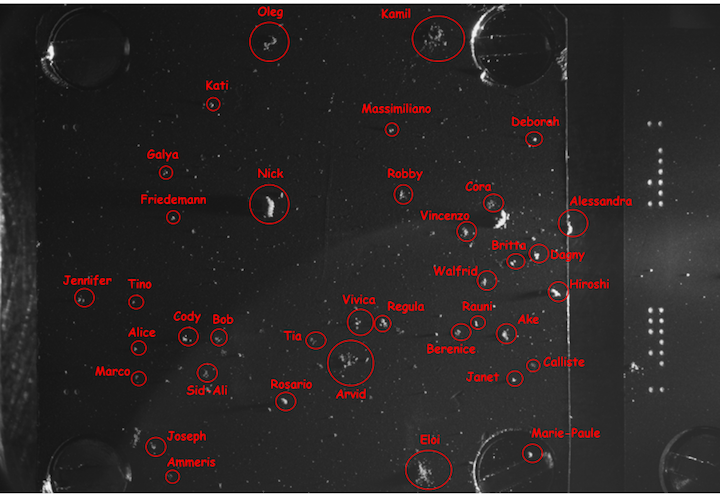
Meet some of the COSIMA grain family! The target plate measures 1cm across, and shows dust grains collected between 11 August and 12 December 2014. Credits: ESA/Rosetta/MPS for COSIMA Team MPS/CSNSM/UNIBW/TUORLA/IWF/IAS/ESA/BUW/MPE/LPC2E/LCM/FMI/UTU/LISA/UOFC/vH&S.
And these targets are small – just one centimetre square each. Of course, the comet dust is even smaller; COSIMA is optimized to study particles a few tens to hundreds of micrometres in size – although the largest particle imaged by COSIMA exceeded 2 mm!
The grains were identified in 9522 snapshots made by the COSIMA microscope, and selected grains were analysed with a secondary ion mass spectrometer. That is, they were fired at with a beam of indium ions, sparking individual ions (secondary ions) from their surfaces, which were then analysed by the mass spectrometer. This process reveals the composition of the grains, which in turn contributes to our understanding about the composition of the primordial matter from the early Solar System.
While at Comet 67P/C-G COSIMA fired its ion beam 8 billion times, resulting in the detection of 35 million silicon secondary ions, 2.8 million carbon ions, 13 million sodium ions and 1 million magnesium ions, as well as generating 34 595 secondary ion mass spectra.
Martin notes: “We had to take a break with these particular measurements after 3 770 secondary mass spectra, between mid autumn 2014 and spring 2015, in order to restore the primary ion gun subsystem which operated outside of the nominal operational parameters. Thanks to the outstanding achievements of Andreas Koch, Laurent Thirkell, Jouni Rynö and Henning Fischer, we could continue using the gun and collected a further 30,825 mass spectra.”
Reflecting on how the team’s personal lives have evolved over the course of the mission, Martin notes that 7 team members and their spouses have collectively had 12 babies since Rosetta launched in 2004. He also notes that all the software written for the COSIMA development, testing, operation and archiving since 1998 has spanned 12 programming languages, more languages than spoken by the 59-strong COSIMA team.
For the software savvy readers amongst you, the 12 programming languages and the number of lines written in each are as follows:
- 4989 lines in Assembly
- 80718 lines in C
- 58591 lines in Erlang
- 37899 lines in Forth
- 16659 lines in Fortran
- 6510 lines in IDL
- 6510 lines in Julia
- 84 lines in KSC
- 909 lines in Octave
- 7288 lines in Python
- 4452 lines in SQL
- 21232 lines in Tcl/Tk
(That’s a total of 245 841 total lines of software code since 1998!)
Programming is not the only thing that happens on Earth while COSIMA is busy collecting dust. The COSIMA team have prepared and worked with 304 reference model test targets for secondary ion yield calibrations as well as instrument parameter fine tuning, and the vacuum pumps of the COSIMA reference model has operated for 102,720 hours.
Like many of Rosetta’s instruments, COSIMA was on the drawing board from an early stage. Martin recalls: “One team member was already involved with Rosetta and COSIMA in 1984, in the very first meeting of the science study team of what was then the “Comet Nucleus Sample Return” cornerstone mission of the newly defined Horizon 2000 program of ESA. In the early 1990s, the mission evolved into a comet rendezvous mission dedicated to the characterisation of cometary material. One of the key arguments at that time was that if we could not bring cometary samples back to the laboratory on Earth, then we should take key laboratory instruments to the comet. COSIMA, along with many other instruments, was already part of the discussion then, and we’re very happy with how it’s all worked out!”
On summing up the highlights of COSIMA’s discoveries, Martin concludes: the tiny bits and pieces of dust particles collected in the coma of Comet 67P/C-G revealed their heterogeneous composition, their fragility and their close family relation to interplanetary dust particles.
This post is part of a series that looks behind the scenes of the instrument teams to find out what it was really like "living with a comet" for two years.
---
THE SURPRISING COMET
As Rosetta began homing in on Comet 67P/Churyumov–Gerasimenko in the weeks leading up to its arrival in August 2014, it became very clear that this was no ordinary comet. But its striking shape was only just the beginning of the comet’s surprises. After more than two years spent living with the comet, Rosetta scientists reflect on some of the mission’s unexpected discoveries, the mysteries solved and the new questions raised.
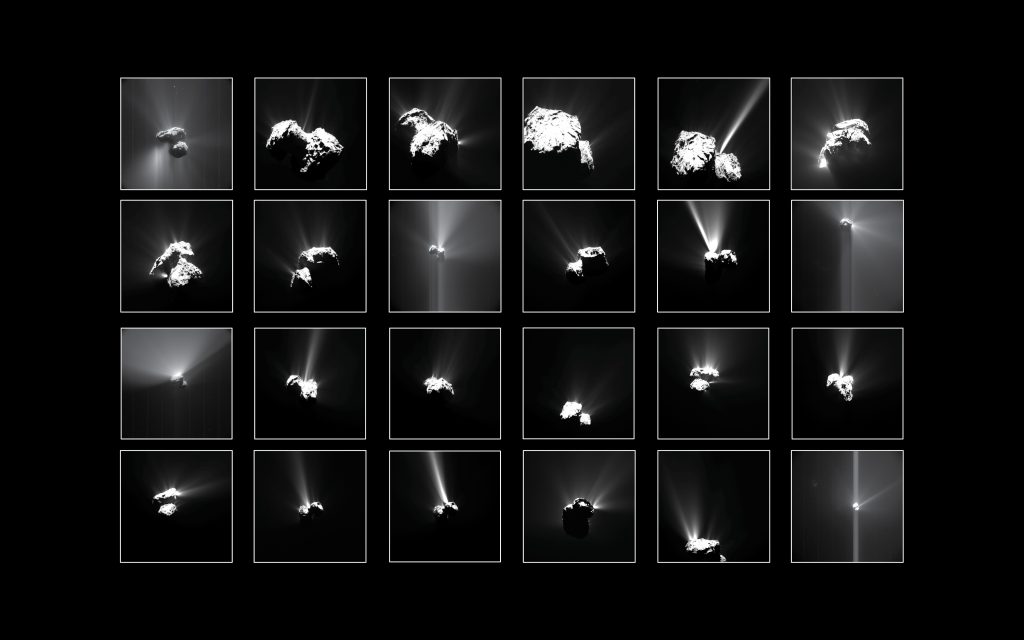
Compilation of the brightest outbursts seen at Comet 67P/Churyumov–Gerasimenko by Rosetta’s OSIRIS narrow-angle camera and Navigation Camera between July and September 2015.
Credits: OSIRIS: ESA/Rosetta/MPS for OSIRIS Team MPS/UPD/LAM/IAA/SSO/INTA/UPM/DASP/IDA; NavCam: ESA/Rosetta/NavCam – CC BY-SA IGO 3.0
“Rosetta has completely changed our picture of comets,” says Eberhard Grün, an interdisciplinary scientist working on the Rosetta mission at the Max Planck Institute for Nuclear Physics in Heidelberg, Germany.
“Previously, they were pictured as dirty ice balls – or, as some prefer, icy dust balls – but now we know them, or at least this one, to be geologically complex worlds where a myriad of processes are at work creating the incredible surface structure and activity of the comet.”
While many of the results from the mission highlight the findings of individual instruments – 11 on Rosetta and 10 on Philae – the role of the interdisciplinary scientists is to keep abreast of the findings of the entire mission, and see how the different results fit together and develop a more comprehensive view of how the comet ‘works’.
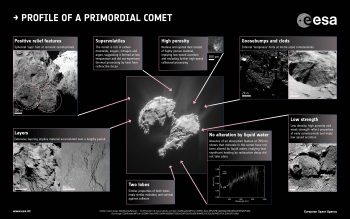 “It is only really in the last few months that it felt like all the pieces of the puzzle were falling into place without effort, and step-by-step it is becoming clearer which of our results are the crucial keys to deciphering the ‘Rosetta stone’ we have in our hands,” says Marco Fulle, also a Rosetta interdisciplinary scientist, based at the National Institute of Astrophysics, Trieste, Italy, and lead author of a papersummarising a number of the most unexpected and significant findings made in the first two years of data analysis.
“It is only really in the last few months that it felt like all the pieces of the puzzle were falling into place without effort, and step-by-step it is becoming clearer which of our results are the crucial keys to deciphering the ‘Rosetta stone’ we have in our hands,” says Marco Fulle, also a Rosetta interdisciplinary scientist, based at the National Institute of Astrophysics, Trieste, Italy, and lead author of a papersummarising a number of the most unexpected and significant findings made in the first two years of data analysis.
One big open question concerned the origin of comets. “This was one of the things I was really looking forward to finding out about: just how primordial are comets?” says Bonnie Buratti from NASA, who acts as their project scientist for Rosetta.
“With the data presented so far, the comet certainly looks pretty primordial, offering us a glimpse of what the building blocks of the planets and moons may have looked like, 4.6 billion years ago.”
Results from Rosetta so far indicate that comets are likely ancient leftovers of early Solar System formation, and not younger fragments resulting from subsequent collisions between other, larger bodies.
Where was the comet born?
“One of the most unexpected and important discoveries was that of molecular oxygen,” says Marco. “Combined with the detection of molecular nitrogen, noble gases and the value of the D/H ratio in the comet’s water , this tells us that the comet was born in a very cold region of the protoplanetary nebula, far from the Sun.”
Nitrogen and oxygen in particular need low temperatures to be trapped in the comet’s ices, so the fact they are observed outgassing today along with water vapour suggests they were incorporated into the comet during its formation.
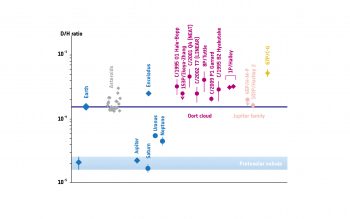
Deuterium-to-hydrogen in the Solar System. Click for full caption. Data from Altwegg et al. 2014 and references therein.
The ratio of deuterium – an isotope of hydrogen with one additional neutron – to normal hydrogen found in the comet’s water holds other important clues to the conditions in which the comet was born.
Theoretical simulations indicate that this ratio should change with distance from the Sun and with time in the first few million years of Solar System history. Since the ratio does not change during a comet’s life, it is an important indicator of the conditions at the time of the formation of its constituent ingredients, and therefore where the comet was most likely born.
The ratio has been measured for 11 comets, mainly via remote observations, and Rosetta’s comet has the highest of them all. This suggests that comets formed over a much wider range of distances from the Sun in the young Solar System than previously thought.
Rosetta’s measurement of the ratio was also one of the most anticipated results of the mission for another reason: its direct link to the source of Earth’s oceans. Was water brought to our planet by comets or asteroids? Rosetta found that its comet’s water is quite different to that of Earth’s, and indeed of other comets and asteroids too, again indicating a diverse origin.
The essence of the question has changed,” says Bonnie. “Now we have to ask: what fraction of the water on Earth came from comets, how much came from asteroids or other bodies, and how much was here to begin with?”
“We have made great progress in starting to address the big questions Rosetta set out to answer, but full answers will take time,” says ESA’s Rosetta project scientist Matt Taylor.
“We have already made inroads into the composition and characterisation of the comet coma. We’ve also studied the surface of the nucleus in great detail, started to classify surface features and regions, and now we’re trying to understand these surface features at a range of scales.”
“Similarities between the scene captured by Philae at its final resting place in Abydos at millimetre-scale and those seen in the Hathor cliff by Rosetta at metre-scale are incredible,” adds Eberhard. “They demonstrate that there is a lot for us to understand about how various physical processes work at different scales, as well as the properties of the material we are looking at.”
Comet shape in control
The shape of the comet and the features on its surface play a role in its activity, driving its seasons, dust transport and influencing the gas densities observed in the coma.
“The comet shape is extremely important to link what we see on the surface of the nucleus to our observations of the coma using both Rosetta’s in-situ instruments and remote sensing,” says Marco.
“Many teams in the Rosetta community, not just the instrument scientists, but also observational astronomers and experts in computer modelling, have been working hard on this topic, and it is a nice surprise to see that their results are in very good agreement: this is not trivial when such a challenging problem is faced for the first time.”
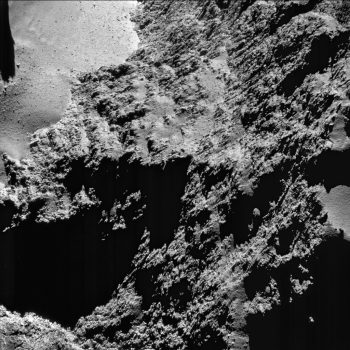
The cliffs of Hathor, seen in a 31 August 2016 view of the comet. Credits: ESA/Rosetta/NAVCAM – CC BY-SA IGO 3.0
For a comet that is constantly changing, this one is apparently doing so with persistent regularity. The comet has been the subject of much attention from Earth-based astronomers, who have recorded similar patterns of behaviour in its activity as it repeats its 6.5 year orbit around the Sun.
“We now know that this is related to the shape of the comet, and the way the release of gas from the two lobes distributes internal stresses between the body and head. This allows the spin axis to remain well fixed in space, which in turn means regular seasons and repetitive behaviour along the comet’s orbit,” says Marco.
Owing to its double-lobed shape and the inclination of its rotation axis, the comet’s seasons are very different between the two hemispheres over its 6.5 year-long orbit. For most of the orbit, the northern hemisphere experiences a very long summer, lasting over 5.5 years, while the southern hemisphere undergoes a long, dark and cold winter.
However, a few months before the comet reaches perihelion – the closest point to the Sun along its orbit – the situation changes, and the southern hemisphere transitions to a brief and relatively hot summer.
These seasons drive the transfer of dust across the comet. During the few months around perihelion, Rosetta has observed that some areas of the northern nucleus received a shower of dust up to a few metres thick, starting with dust grains of a few millimetres across and up to metre-sized objects.
“Although it is misleading to transfer our terrestrial experiences to a comet, let’s fantasise for moment,” says Marco. “If we were standing on the comet, I could imagine this dust movement to be like a very calm and gentle pumice-fall, albeit with dust up to giant beach ball size, during a night with a sustained breeze – but too tenuous to be felt – coming from the south.”
While some of the dust is redistributed around the comet in this way, some particles are also ejected at speeds high enough to escape the gravity of the comet. A tiny fraction was then collected by Rosetta’s dust-analysing instruments.
“The dust ‘showers’ recorded by the GIADA instrument were one of the most surprising observations of the mission for me,” says Marco. Dust showers describe a cluster of dust particles detected by the instrument over a sustained period; some previously reported showers were observed to last 0.1– 30 seconds.
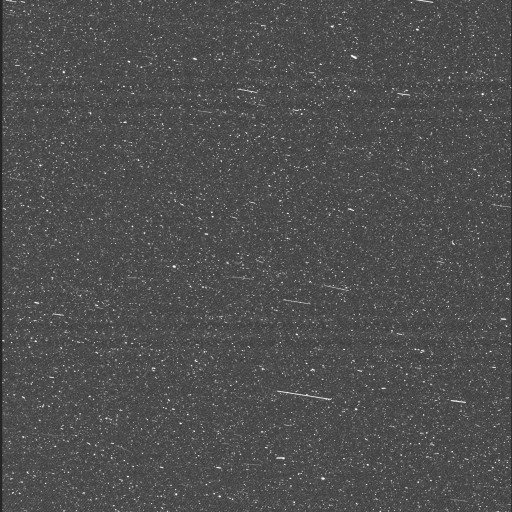
Comet's dusty environment. Credits: ESA/Rosetta/MPS for OSIRIS Team MPS/UPD/LAM/IAA/SSO/INTA/UPM/DASP/IDA
“It was something we had never seen before and had not been expected, so it generated quite some discussion. Luckily, more and more instruments are confirming that the very fluffy, very big and very charged dust particles we suggested to explain these weird observations may really exist, although we are still working out the wider implications.”
Nicolas Altobelli, ESA’s deputy Rosetta project scientist, was also particularly fascinated by the dust observations: “I found it incredible that for the first time we could see grains of dust collected and imaged or scanned by the COSIMA and MIDAS instruments.”
These grains are linked to the interplanetary dust particle populations that are thought to have grown into larger and larger agglomerations of particles during the early phases of Solar System formation. To understand how comets are formed, scientists need to understand the structure of the smallest grains and how they are built.
“Before Rosetta, the only way to study them was to go on an expedition to Antarctica to collect meteorites preserved in the snow and to look for interplanetary dust grains inside them,” says Nicolas. “But those grains might have been altered by the entry of the parent body through our planet’s atmosphere and by the time spent in the snow. With Rosetta, we have a direct delivery of pristine material from the source.”
But how the dust actually leaves the surface of the comet is still an open question. “To win against the low gravity of the comet is easy, but overcoming the stronger Van der Waals electrical forces binding the dust particles to each other still remains a mystery,” adds Marco.
Surprises further afield
Matt has a background in plasma physics and was especially looking forward to monitoring how the comet would interact with its environment as it hurtled through space along its orbit around the Sun.
“One of the biggest surprises for me was the detection of the diamagnetic cavity. The spacecraft was on orbits around the comet way beyond where everyone thought this region might form, and so we weren’t expecting to see it.”
The diamagnetic cavity is a region devoid of magnetic field, arising at the interface between the incoming solar wind and the outflowing gas from a comet. Based on previous observations at other comets, theoretical simulations had predicted that such a cavity would extend only 50–100 km from the nucleus during the comet’s most active months, but one of the first detections made by Rosetta was at 170 km.
“Rosetta has shown that this region and its boundary are particularly dynamic and as a result we’ve been lucky enough to make a number of observations of the boundary as the magnetic field-free region repeatedly passed around the spacecraft,” says Matt.
“In addition, we discovered the ‘song’ of the comet , driven by plasma waves, and a set of plasma boundaries so unusual that we will be digging through the data for years to come.”
A generation of comet chasers
The results of Rosetta are helping to put the observations of other comets in context and vice-versa: without the results of previous missions, some of Rosetta’s results would be hard to understand.
“For example, the ‘holes’ left over after active regions peter out look like those we saw on Comet 81P/Wild-2 from larger distances,” says Bonnie. “We also see similarities in the ‘ponding’” of dust, and features that remind us of wind-blown processes on Earth. These seem to be common on comets.”
“The results of NASA’s Stardust mission to 81P/Wild-2 certainly helped us to better understand our dust,” adds Marco.
“Comparing the results of various missions is not trivial. Most missions prior to Rosetta only collected snapshots as they flew past their targets, so it is hard to understand how representative those brief observations were of each comet, especially in terms of their composition.
“We need a patient observer like Rosetta, following its target during the whole orbit, to avoid any bias in the measurements due to local or sporadic events, or the effect of the comet’s seasons on the coma, for example.”
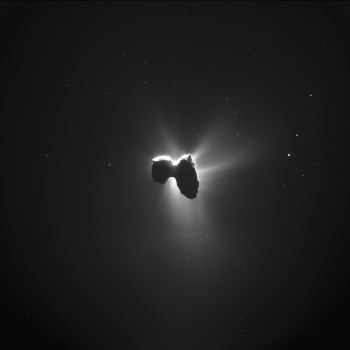 This is only the beginning
This is only the beginning
But even with over two years of data now safely collected, tracking the comet through its most active period as it passed through perihelion, and giving unrivalled insight into the evolution of the comet, this is still only the beginning of Rosetta’s big discoveries.
“To me, the importance of Rosetta lies more in the potential the data have than what we’ve already discovered,” says Eberhard. “The abundance of data we obtained during Rosetta’s two-year rendezvous will eventually unveil the deep secrets of this comet.”
Matt agrees: “For me, the big answers will surely come by piecing all of this together and combining observations with new models – which can now be improved thanks to Rosetta’s results – to address how comets work, where they come from and how they fit into Solar System’s history.
“Now that the operational side of the mission is drawing to a close, we’ll have much more time to delve into this treasure trove of data.”
“Rosetta has certainly shown us that what she observed was in many cases quite different from what we had planned,” reflects Marco. “But it is the surprises that will surely make Rosetta the key to understanding our own as well as other solar systems.”
Quelle: ESA

